Basic Overview of a Salmon's
Life History
Characterized by grace and beauty, a
silvery sheen and spotted back and fins, the family Salmonidae is native to the North
Temperate Zone, and the fish known to us a salmon are restricted to the rim of the North
Pacific on the North American and Asiatic coasts, and to a far lesser extent on the
European and North American coasts of the North Atlantic. The family includes a large
number of fish such as steelhead, trout and char, as well as the five types familiar to
Pacific coast anglers.
Pacific salmon belong to the genus
Oncorhynchus, a melding of two Greek words meaning "hooked snout". Popular and
scientific names for the five species are: sockeye (O. nerka);
pink (O. gorbuscha); chum (O.
keta); coho (O. kisutch) and chinook
(O. tschawytscha).
An anadromous animal, the Pacific
salmon breeds and spends varying portions of its life in fresh water, then travels to the
ocean to feed until maturity. This is in contrast to pelagic species which are born and
live solely in the sea. Each of the five species of salmon differs in its life history,
with pinks, for example, living only two years and reaching a weight of little more than
five pounds, while the giant chinook can reach over 120 pounds and lives up to seven
years.
Salmon are born in gravel beds in
streams anywhere from a hundred yards to 1000 miles from the sea. Laid in the fall,
the eggs incubate for several months and then hatch into what are known as alevins, tiny
fragile things with huge eyes and sack-like appendages, and shortly thereafter they emerge
from the gravel as inch-long fry. In the river, or a nearby lake, depending on the
species, they feed and grow for periods ranging up to a year or more. Then in the spring,
during the season of freshets, they head downstream to the sea. They are called
fingerlings during this phase of their lives, and are up to four inches long. In the sea
they spend varying amounts of time ranging up to five years, eating greedily and growing
rapidly in the bountiful ocean feeding grounds. In early summer of their maturing year
they begin to head back to their home streams, navigating by their simply incredible sense
of smell.
They stop feeding as they enter fresh
water, living on stored body fats. They struggle, often for weeks or months, against
rapids, falls, obstructions in the form of fallen logs and rocks until, bruised and
travel-worn they reach the placid waters of the spawning river where they were born. The
female digs a nest, or redd, in the gravel, hollowing out a cavity up to 18 inches deep.
She prefers a place in a riffle, where the fast-running water will provide an ample supply
of oxygen for the eggs. When the nest is ready, which may be weeks after the spawner has
reached the gravelbeds, the female lays her eggs. Up to 15,000 eggs are deposited in
the gravel, and soon after, the male fertilizes them by covering them with a milky
substance known as milt.
With spawning over, the salmon's life
is finished, and within a short time it dies, and the body drifts downstream.
In the ocean, the
sockeye,
pinks and
chums feed primarily on plankton and
crustaceans such as tiny shrimp, while
chinook and
coho
eat smaller fish, making them vulnerable to commercial and sports fishermen using bait
such as herring. Sockeye and chinook are the most hardy of the family,
traveling as far
as 1,000 miles upstream to spawn. Chums, coho and pinks usually spawn closer to the sea.
Pacific Salmon
Species
Chinook
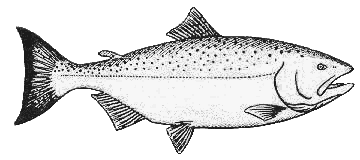
Patriarch of the salmon family is the
chinook or king, called a spring by Canadian fishermen, and a quinnat by Indians in
Alaska. Largest of the species, they also live the longest.
Chinook may be seen in upriver
migrations almost any month of the year, but they favor the spring and fall. Their
spawning grounds extend from a few miles to over 1,000 miles inland, and the early runs
make the longest journey. Most young chinook fry go to sea very soon after hatching, but
others remain in a lake or river for one and sometimes two years before making their way
downstream.
The pattern of their life at sea is
not as rigidly set as that of the other species, and mature chinook can range from three
to seven years. The majority are four to five years old when they return to spawn, and
range in weight from 10 to 50 pounds. Some giants have been taken in both the
commercial and sports fisheries, however, with the commercial record being 125 pounds. The
sports record for chinook is 97 pounds ... taken in Alaska's Kenai River.
Jacks are quite common among chinook (
just as they are among coho and sockeye). These three to four pound males mature after
only one year at sea and may be two or three years old, depending on whether they went to
sea directly as fry or remained in fresh water for one year. Blackmouth (immature feeder
chinook) similar in size and appearance to immature coho, are often taken in the salt
water sports fishery. They are distinguished from coho by black pigmentation along the
base of the teeth on the lower jaw.
Chinook are not often easily seen on
the spawning grounds, for they normally choose deeper spawning areas. Unlike the other
Pacific salmon, their body shape does not change much during spawning. The color turns
from bright silver of the sea life to a dark brown, sometimes approaching black. Males and
females are closely similar, except for the males' larger size.
Coho
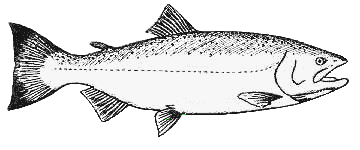
Coho are sometimes known as blueback
when caught before full maturity, and also as silvers. They are the most popular game fish
of the salmon family, as well as one of the most valuable commercial species.
Adult coho migrate up the Alaskan
rivers primarily in August while Washington rivers see returns in October and November. As
a general rule, they choose streams close to the ocean, although some journey as far as
900 miles inland.
In contrast to other salmon, young
coho fry remain in their spawning stream for a full year after emerging from the gravel,
and for this reason they are exposed more than the other species to the perils of floods,
droughts, stream pollution, predation and other hazards common in areas of dense
population. After living in the stream for a year, they drift down to the sea where they
feed for 16 to 18 months. Their age at maturity is normally three years.
Some male coho attain sexual maturity
at the end of their first summer in the ocean, and return to the spawning grounds as jacks
weighing one to three pounds. In the spring of their second year at sea, coho are often
called bluebacks. They are in their third year of growing, having spent the first year in
fresh water, and weigh from three to four pounds. In the fall, only five months later,
they have reached a size of six to 12 pounds and are fully mature, ready for migration
back to their home streams.
Sockeye
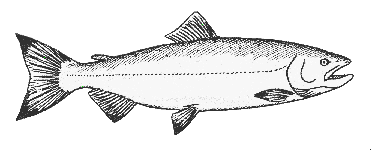
Known to fishermen on the Columbia
River as bluebacks and to Alaskans as reds, the sockeye is historically our most
commercially valuable fish because of its high oil content and ability to hold its red
color in the can.
Sockeye spawn in streams having lakes
in their watershed, for young sockeye do not survive unless they spend between one and
three years in a lake before migrating to sea.
In the spring, from early May to the
end of June, young sockeye fingerlings leave their lake rearing areas and move downstream
to the sea. They move rapidly out of the estuaries and thousands of miles into the Gulf of
Alaska and the North Pacific where they feed voraciously. In their third year at sea they
begin sexual development, and between this time and the sixth year they return to their
natal spawning stream. Mature four-year-old sockeye average six pounds and older age
groups reach 12 pounds.
Males on the spawning grounds have a
humped back and sharply hooked nose, while female sockeye retain their natural shape. Both
sexes turn from their normal blue-tinged silver color to varying shades of red when they
reach the spawning streams.
Sockeye which through accident or
design become "lake-locked" and never go to sea are called kokanee. These
sockeye, which live exclusively in fresh water and also die after spawning are identical
in their life cycle to the sea-going sockeye, except that they are generally much smaller.
The incalculable feeding capacity of the open ocean is dramatically illustrated by the
average six-fold difference in size between the freshwater kokanee and their sea-going
kin.
Chum
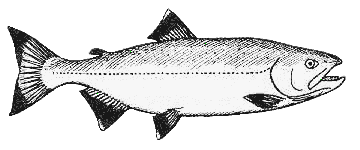
Chum salmon, also known as keta and
dog salmon, are usually the last of the Pacific salmon to enter fresh water, generally
spawning in early winter. Exceptions to this rule are the few summer chum runs returning
to northern British Columbia streams. Spawning grounds are usually in the lower
tributaries along the coast, rarely more than 100 miles inland. Rivers such as the Yukon
are the exception.
Eggs are deposited in the gravel from
December to February with the fry emerging in the spring. Chum fry are long, slim and
silvery, with a blue-green iridescence quite distinct from the fry of other Pacific
salmon, and go directly to sea with no hold-over residence in either stream or lake. In
the third or fourth year the chum reaches maturity, weighing from 8 to 18 pounds, another
example of the remarkably rapid growth made possible by a salt water environment.
On the spawning grounds chums are
easily distinguished from other salmon by the distinct dark vertical bars along the sides
of the fish. Color ranges through blacks and grays to a drab reddish hue in the advanced
stages of spawning. Males develop such a sharply hooked nose that their large dog-like
teeth become totally exposed. Females have the barred coloration along the sides but do
not have the other characteristics.
Pink
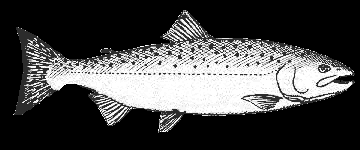
Pink salmon, also known as humpback or
humpies to fishermen, live only two years and have a relatively simple life cycle. Adults
leave the ocean in the late summer and early fall and usually spawn in streams not fed by
lakes, a short distance from the sea. In the winter following spawning, the tiny one-inch
fry drift directly downstream to the sea as soon as they emerge from the gravel. Of all
salmon, except chums, pinks spend the least time in fresh water, for except their period
of incubation in the gravel, they spend their entire two years in the rich ocean feeding
areas. Their ocean growth is remarkably rapid with average weights ranging from three to
six pounds at maturity.
On the spawning grounds the males
develop an extremely humped back, a grotesque disfiguration. Females do not change their
body shape. Both sexes change color from bright ocean silver to pale gray on the back with
a white to yellowish belly. In contrast to the vivid red of the sockeye, the somber gray
pink salmon on the spawning grounds are difficult to see, as they blend with the stream
colors.
Steelhead
Trout

The steelhead trout ( Oncorhynchus
mykiss ) is really no more than an ocean-going version of the rainbow trout that so
many anglers are familiar with.
Unlike all Pacific salmon, steelhead
do not always die after spawning, although a large number (especially males) do not
survive the rigorous spawning process. Some steelhead are able to spawn three or four
times during their lifetimes ... returning to the ocean to feed for 10 months or so
between each spawning run.
Steelhead have the most complicated
life history of any of the anadromous salmonids. Steelhead may spend anywhere from one to
four years and freshwater and one to four (rarely a little more) years in the saltwater
... differing combinations of these fresh / saltwater years create many possibilities for
life cycles.
The repeat spawning fish throw even
more possibilities into the pot with some fish spending one year in the ocean between
spawning runs, others two, or even three years. It is known that the very largest of the
returning steelhead are first-time spawners.
Steelhead are found from the Asiatic
coast, through southern Alaska and down the Pacific coastline to central California ..
although they were originally found as far south as the Tijuana River in northern Mexico.
Ocean feeding grounds are spread out
over the North Pacific, although exactly where remains a mystery. It is known, however,
that they often roam a great distance from their natal streams ... years ago, a fish
tagged in the Sea of Japan was caught just six months later in the Skagit River of
northern Washington.
Steelhead generally run about four to
eight pounds when returning as adults. Some streams, however, see returning adults that
average in the teens and often exceed twenty pounds. Fish approaching fifty pounds have
been taken in tribal net fisheries, but the largest sport caught steelhead is 43 pounds,
taken by a boy fishing in a small raft in the marine waters of Southeast Alaska ...
originally, the fish was believed to be a chinook, but the taxidermist who was to mount
the fish noticed the difference and sent the fish to the University of Washington for
confirmation on the identification.
Steelhead may venture as far inland as
1000 miles to spawn, however, most are found nearer the ocean waters. Some streams host
two runs of steelhead, a summer run (returning in summer and early fall and spawning in
early to mid-winter) and a winter run (returning in early winter to late spring and
spawning anywhere in this time frame).
Returning steelhead fresh out of ocean
carry a blue-black spotted back with silver sides and a alabaster belly (we refer to these
fish as 'two-tone cruisers', or 'chromers') with fish that spend time in the river
returning to the traditional colors of a rainbow trout.
Pacific
Halibut
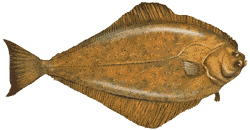
Pacific halibut (Hippoglossus
stenolepis) can be found throughout most of the marine waters of the North Pacific.
Halibut are the largest of all the flatfishes and are distributed along the continental
shelf of the North Pacific from Southern California to Nome, Alaska and along the coasts
of Japan and Russia. Halibut are demersal fish, being found on or near the bottom over
mud, sand, or gravel banks. While halibut have been recorded at depths of 3,600 feet, most
are caught at depths of 90 to 900 feet. Halibut generally are in deeper waters during the
winter where they spawn at depths of 600 to 1,500 feet during the period from November
through March. Following spawning, halibut begin to migrate to shallower coastal summer
feeding areas.
Male halibut become sexually mature at
approximately eight years old while females typically are not mature until age 12. A
female can release from 1/2 to 4 million eggs depending on the size of the fish. After
spawning, the eggs float near the bottom and hatch into larvae after approximately 15
days. These larvae are free floating and are subject to movements by deep ocean currents.
As the larvae mature, they move higher in the water column where surface currents move
them to shallower coastal waters. These currents generally carry the eggs and larvae in a
northwesterly direction.
Halibut larvae begin life in an
upright position similar to other fish with an eye on each side of the head. However, when
the larvae are approximately one inch long, they undergo an amazing transformation in
which the left eye moves over the snout to the right side of the head and the pigmentation
on the left side of the fish fades. The young halibut take on the features of adult fish
approximately six months after hatching and settle to the bottom in shallow, nearshore
areas. The halibut now have both eyes on the pigmented (olive to dark brown) side of the
body while the underside of the fish is white.
During their first year of life, they
feed on plankton. Young halibut (1-3 years old) feed on small shrimp-like organisms and
small fish. As halibut increase in size, fish make up a larger part of the diet. Besides
pollock, sablefish, cod, and rockfish, large halibut also eat octopus, herring, crabs,
clams, and smaller halibut.
While halibut can live to be up to 40
years old, grow to over eight feet long, and weigh over 500 pounds, most halibut caught in
the sport fishery will be 8-15 years old and weigh between 10 and 100 pounds. Female
halibut live longer and grow faster and larger than do males. Few males exceed 80 pounds
and generally all halibut over 100 pounds are females. The oldest halibut on record was a
42 year old female while the oldest male observed was 27 years old. The age of halibut is
determined by a bony structure in the inner ear called an otolith. As the fish grows,
annual growth rings are formed on the otolith, similar to rings on a tree.
Halibut typically move to deeper
waters as they grow older. Besides the seasonal movement from deeper waters in the winter
to shallower waters in the summer, halibut may also undergo intensive geographic
migrations. Halibut tagged in the Bering Sea have been caught as far south as the coast of
Oregon, a migration of over 2,000 miles. This migration is generally in an easterly and
southerly direction, counter balancing the northeasterly drift of the eggs and larvae.
|

